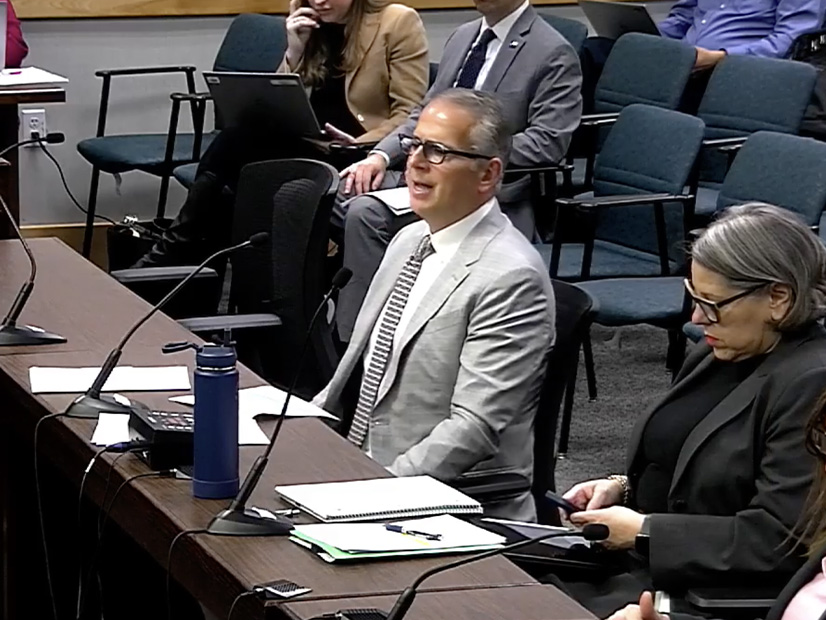
After a two-month delay, ERCOT on Feb. 13 released its semiannual Capacity, Demand and Reserves report, which provides potential future planning reserve margins five years into the future during the high-demand periods of the winter and summer seasons.
According to the report’s most dire scenarios, the Texas grid operator may not have enough power to meet that peak demand during next year’s summer. However, ERCOT said in a statement that the CDR report is a “snapshot of potential supply resource availability and demand” and is not intended to represent expected real-time operations scenarios.
The report was delayed so that revisions to its parameters could be made to “better represent the performance of grid resources and the dynamic nature of the ERCOT grid,” the grid operator said.
ERCOT CEO Pablo Vegas appeared before the Texas Public Utility Commission to roll out the report. He told the commissioners that the state’s “fast-growing” environment, with large loads able to quickly connect to the grid before the infrastructure is ready, has placed “downward pressure on planning reserves.”
“We see that trend continuing in this CDR as well,” Vegas said. “Some of the changes that we’ve made have accelerated or changed the view of those planning reserve margins shrinking, but … the overall trend of a rapidly growing economy, rapidly growing demand as a result of that … the energy economy is working to keep up with that.”
The CDR projects PRMs, currently 18.9% for peak load and 10.5% for net peak load (when solar generation drops during the early evening hours when loads are still high), will fall to 8.3% and 21%, respectively, during summer 2027. The 2027/28 winter PRMs also drop into negative territory.
ERCOT last year projected demand would reach 150 GW by 2030, fueled by data centers, industrial and petroleum production facilities, and cryptocurrency miners. The CDR projects demand to peak at 140 GW in 2029. The grid operator’s current peak is 85.5 GW, set in August 2023.
“It’s important to note that all scenarios in this report have a certain level of uncertainty that can alter the long-term resource adequacy outcomes, and these forecasts will change over time based on a variety of factors,” ERCOT said in releasing the report.
Skepticism
The release was met with skepticism by several industry insiders.
Stoic Energy’s founder, Doug Lewin, jumped on a comment made by Vegas to the PUC that the CDR “doesn’t model what the market would typically do.”
“Exactly,” Lewin said as he moderated a discussion on his Substack feed. “I think this report is largely worthless. Might be worse than worthless because people panic for no good reason.”
Pointing to an ERCOT slide with PRMs between 32.4 and 21%, Lewin said it “looks scary, but it’s in no way reflective of the reality of the market. So, what’s the point?”
The “Texas CDR report is far less important fundamentally than in the past years and is more a political signal in 2025,” Julien Dumoulin-Smith, a financial analyst with investment banking and capital markets firm Jefferies, said in an email to his audience.
“The optics of … -2 to -33% reserve margins likely leads to a political response,” he said, saying those optics likely will lead to efforts to subsidize generation and potentially less support for data centers.
Dumoulin-Smith said that draft legislation (Senate Bill 6) could be “adverse” for power companies. The bill would require a “minimum transmission fee” based on large users’ peak load; require disclosure of backup generation; require PUC approval for any data center to buy existing thermal generation’s output; and establish a new ancillary service similar to ERCOT’s current emergency response service to “competitively procure demand reductions from large load customers” with 24-hour notice.
The changes to the CDR include new load forecasts, as directed by House Bill 5066, that come directly from transmission and distribution utilities’ projections of new loads. Previously, ERCOT staff only counted loads with signed connection agreements.
It now will use effective load-carrying capabilities (ELCCs) to measure renewable resources’ and battery storage’s reliability contributions. The ELCC metric is used in most capacity markets, but ERCOT operates an energy-only construct.
The CDR also will illustrate both peak and peak net reserve margins and include demand-side resources such as demand response programs. ERCOT said the potential 9.72 GW of thermal generation in the Texas Energy Fund (TEF) did not meet the rules for inclusion in the base CDR scenario. It said additional scenarios did include the full TEF generation portfolio’s potential effect on reserve margins.
“The new parameters and scenarios in the CDR better represent the performance of grid resources and the dynamic nature of the ERCOT grid,” ERCOT said.
“The methodology changed significantly and … is extremely suspect. ELCC is a massively flawed metric,” Lewin said, noting “centrally planned, administratively determined capacity values” are necessary in capacity markets, but not in an energy-only market.
“That’s part of the point of an energy-only market. Markets are far better at determining which resources can meet demand,” Lewin said. “Very hard to get good enough data to determine these things administratively. You’ll always be behind.”
The CDR, originally released at 9:33 a.m. Feb. 13 in a market notice, was revised twice to reflect corrections to formulas in the “load-resource scenarios” tab that affected TEF scenarios.
Dumoulin-Smith said “significant math errors” overstated projected supply in 2029 by about 28 GW, a “substantial delta” on an approximate 100-GW base. The initial report had one reserve margin of 22% that was corrected to 3.9% in the second report and uses a “stale” load forecast from summer 2024, he said.
The analyst said he is “doubtful” many of the TEF projects will be completed without further support. Texas Lt. Gov. Dan Patrick (R), as president of the state Senate, has said he might seek $5 billion in state funds as incentives to build more natural gas power plants; the TEF’s In-ERCOT Generation Loan Program already has been allocated $5 billion for low-interest loans, but the current portfolio will require $5.34 billion in loaned funds.
ERCOT says future economic growth will provide opportunities to improve PRMs. It says potential short-term solutions include expanding DR capabilities and broadening the firm-fuel supply service program. It also says it could further improve energy storage optimization and work with large loads on flexibility capabilities.
“ERCOT looks forward to working on short- and long-term solutions with the Texas Legislature, PUC and stakeholders to continue to strengthen the reliability and resiliency of the Texas power grid,” CEO Vegas said.


